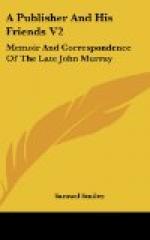April 12, 1817.
Our friend Southey has got into a confounded scrape. Some twenty years ago, when he knew no better and was a Republican, he wrote a certain drama, entitled, “Wat Tyler,” in order to disseminate wholesome doctrine amongst the lower orders. This he presented to a friend, with a fraternal embrace, who was at that time enjoying the cool reflection generated by his residence in Newgate. This friend, however, either thinking its publication might prolong his durance, or fancying that it would not become profitable as a speculation, quietly put it into his pocket; and now that the author has most manfully laid about him, slaying Whigs and Republicans by the million, this cursed friend publishes; but what is yet worse, the author, upon sueing for an injunction, to proceed in which he is obliged to swear that he is the author, is informed by the Chancellor that it is seditious—and that for sedition there is no copyright. I will inclose either now or in my next a second copy, for as there is no copyright, everyone has printed it, which will amuse you.
On July 15th and 20th Lord Byron wrote to Mr. Murray that the fourth canto of “Childe Harold” was completed, and only required to be “copied and polished,” but at the same time he began to “barter” for the price of the canto, so completely had his old scruples on this score disappeared. Mr. Murray replied, offering 1,500 guineas for the copyright.
Mr. Hobhouse spent a considerable part of the year 1817 travelling about in Italy, whither he had gone principally to see Lord Byron. He wrote to Mr. Murray on the subject of Thorwaldsen’s bust of the poet:
“I shall conclude with telling you about Lord B.’s bust. It is a masterpiece by Thorwaldsen [Footnote: The bust was made for Mr. Hobhouse, at his expense. Lord Byron said, “I would not pay the price of a Thorwaldsen bust for any head and shoulders, except Napoleon’s or my children’s, or some ‘absurd womankind’s,’ as Monkbarns calls them, or my sister’s.”] who is thought by most judges to surpass Canova in this branch of sculpture. The likeness is perfect: the artist worked con amore, and told me it was the finest head he had ever under his hand. I would have had a wreath round the brows, but the poet was afraid of being mistaken for a king or a conqueror, and his pride or modesty made him forbid the band. However, when the marble comes to England I shall place a golden laurel round it in the ancient style, and, if it is thought good enough, suffix the following inscription, which may serve at least to tell the name of the portrait and allude to the excellence of the artist, which very few lapidary inscriptions do;




